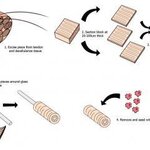Genetics & Molecular Biology

Not all isolated stem cells are equally valid in regenerative medicine and tissue engineering - only a specific group of cord blood stem cells (CB-SC) maintained in culture are useful for therapeutic purposes, say researchers in a new paper.
At present, cord blood stem cells
- adult stem cells - are key to regenerative medicine and tissue engineering. From all types of
cord blood stem cells
those called "Wharton's jelly stem cells" (HWJSC) have piqued the interest of specialists in regenerative medicine at the University of Granada and Alcalá de Henares University, because of…

While diet and exercise are guaranteed to eliminate obesity, there can sometimes be a biological issue that arises, making it harder to lose fat.
Pop culture diet doctors selling books have done a lot of damage by recommending people not just diet because they claim the metabolism 'slows down' and stores more fat and burns less energy. It happens, but not enough for most people to not simply diet.
Researchers at Sanford-Burnham Medical Research Institute have a new hypothesis about how this 'starvation' defensive mechanism may get activated - a protein called p62. According to a…

Collagen, the most abundant protein in the body, is widely used to build scaffolds for tissue engineering because it is biocompatible and biodegradable. Collagen is, however, hard to work with in its natural form because it is largely insoluble in water, and common processing techniques reduce its strength and disrupt its fibrous structure.
Tufts University School of Engineering researchers have developed a new method for fabricating collagen structures that maintains the collagen's natural strength and fiber structure, making it useful for a number of biomedical applications.
The new…

Researchers have fabricated an artificial protein in the laboratory and examined the ways living cells respond to it.
The research results describe a peculiar set of adaptations exhibited by Escherichia coli bacterial cells exposed to a synthetic protein, dubbed DX. Inside the cell, DX proteins bind with molecules of ATP, the energy source required by all biological entities.
After exposure to DX, the normally spherical E. coli bacteria develop into elongated filaments. Within the filamentous bacteria, dense intracellular lipid structures act to partition the cell at regular…

Shocks to your metabolism are a good thing but you can't let them be persistent.
People who are jet-lagged, work graveyard shifts and late-night snackers are engaging in activities that upset the body's "food clock," a collection of interacting genes and molecules known technically as the food-entrainable oscillator, which keeps the human body on a metabolic even keel. That happens with binge eating during the holidays too.
A new study says the protein PKCγ is critical in resetting the food clock if our eating habits change. Normal laboratory mice given food only during…

Researchers have identified an enzyme, PRSS3, specifically linked to aggressive prostate cancer, and have also developed a compound that inhibits the ability of this molecule to promote the metastatic spread of the cancer.
They made the discovery by investigating publicly available databases, derived from clinical studies, which contain data on molecules that are upregulated - irregularly switched on - in cancer. They had previously discovered a link between the protease and the earlier stages of breast cancer. The research team wanted to see if any other cancer abnormally…

Scientists have found three new and relatively rare genetic variants that influence insulin production, offering new clues about the genetic factors behind diabetes.
Diabetes, which affects more than 25 million people in the United States, results from problems with the body's ability to produce or use insulin. Rather than pinpointing one gene behind the disease, scientists believe there are a whole host of genes that interact with health and lifestyle factors to influence a person's chances of getting the disease.
The study revealed that certain variants of three genes — called TBC1D30,…

Researchers have completed the first genome sequence of domestic goat by integrating next-generation sequencing (NGS) and whole-genome mapping (WGM) technologies. The goat genome is the first reference genome for small ruminant animals and may help to advance the understanding of distinct ruminants' genomic features from non-ruminant species.
This work also yields a valuable experience for facilitating the de novo assemblies of large, complex genomes in the future.
Goats are recognized as an important member of the world livestock industry, and with many unique biological features.…

The Australian mega bat and a Chinese micro bat may provide clues to the future treatment and prevention of infectious diseases and cancer in people, say researchers.
These bats evolved flight, resistance to viruses and the ability to live relatively long time, say the team sequencing the genomes of the two bat species. They then compared the bat genomes to the genomes of eight other mammals, including humans, to find similarities and differences.
"A deeper understanding of these evolutionary adaptations in bats may lead to better treatments for human diseases, and may eventually…

The study of epigenetics in psychiatry promises several key advances, as noted by Eric J. Nestler, M.D., Ph.D., a Deputy Editor for Biological Psychiatry and an expert in this field.
First, it enables, for the first time, direct study of mechanisms controlling transcription, the process of expressing the genetic information coded within DNA, in the brains of behaving animals as well as in brain tissue from humans studied at autopsy.
Second, some epigenetic changes in the brain are likely to be extremely long-lived, and thereby represent potential mechanisms by which life events, or…